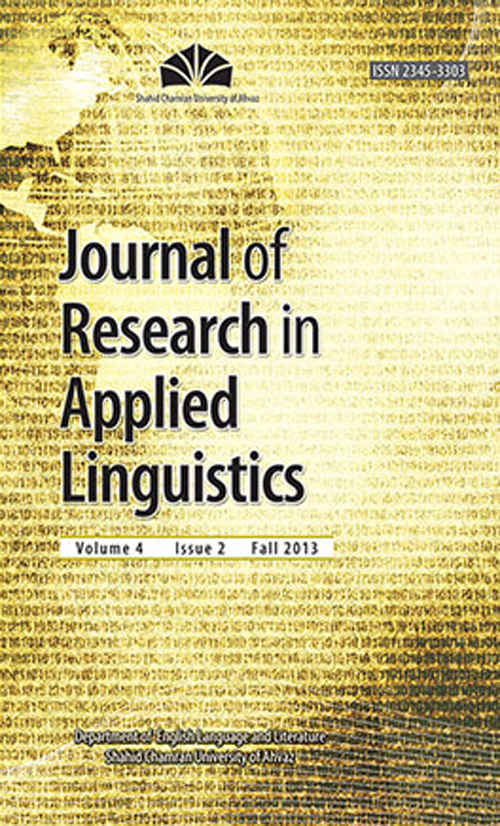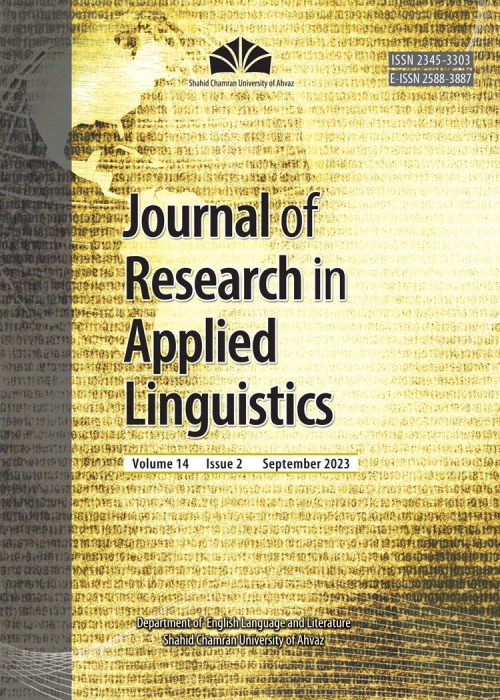فهرست مطالب

Journal of Research in Applied Linguistics
Volume:4 Issue: 2, Autumn 2013
- تاریخ انتشار: 1393/02/25
- تعداد عناوین: 10
-
-
Page 3Research shows a positive relationship between self-directed learning (SDL) and reading comprehension. The present quasi-experimental study attempted to expand the scope of SDL by investigating its effect on the components of reading comprehension. Sixty high school students took the reading comprehension part of PET as the pretest and the posttest. Over 16 weeks, the experimental group, consisting of 30 students, underwent instruction in SDL. Data from the pretest was analyzed using an independent samples t test. Results [t(1.158 = 0.157, p > 0.87)] indicated that the 2 groups were homogeneous before the treatment. After the treatment, the data from the posttest were analyzed using a one-way between-groups MANOVA. Results between the 2 groups on the combined dependent variables [F(5,54) = 0.72), p =. 61], Wilk’s Lambda=. 93, and partial eta squared =.06 displayed no significant difference, and this may be due the fact that SDL is not compatible with Iran’s system of education.Keywords: Self, Directed Learning (SDL), Reading Comprehension, Components of Reading Comprehension
-
Page 16This study investigated the effectiveness of individual and collaborative outputbased focus-on-form instructional tasks on the acquisition of English inversion structures by EFL learners. Moreover, it explored the developmental trend of learners’ inversion acquisition. To this end, 60 homogeneous EFL learners were assigned to individual and collaborative output groups. They were exposed to texts encompassing inversion structures for 12 instructional sessions. The task included dictogloss in both groups where the texts were reconstructed either individually or collaboratively. A pretest, posttest, and delayed posttest design was used to examine the effects of the 2 tasks. The learners’ process of acquisition was examined by parallel tests of inversion development. Results showed that collaborative task implementation was advantageous over individual task performance in both immediate and delayed posttests. Results did not reveal a linear additive process forthe collaborative output group; however, the findings suggest that collaborative language production can enhance grammatical acquisition.Keywords: Collaborative Output, Dictogloss, EFL Learners, Individual Output, Inversion Structures
-
Page 33The present study aimed at investigating the specific discourse cycles of some introductory textbooks across disciplines and languages to see to what extent they acculturate students into the new subjects. To this end, 2 well-established and mostlyused English and Persian introductory textbooks in sociology and 2 other wellestablishedEnglish and Persian introductory textbooks in linguistics were examined. The study was conducted with reference to Love’s (as cited in Hewings, 2006) suggested framework for the analysis of introductory textbooks. The texts were analyzed in terms of the intradiscourse cycles. Then, the introductory textbooks from the 2 disciplines were compared and contrasted in order to determine their similarities and differences in acculturating students into the discipline. Results showed that though in the English introductory textbooks, the cycles either started with theory, data, or culminated in cutting-edge, real time problematization, in the Persian texts, the cycles less frequently culminated in problematization of the interpretive process. The study suggests that this kind of analysis enhances both teachers’ and students’ knowledge concerning the process of acculturation into their disciplines.Keywords: Acculturation, Discipline, Introductory Textbooks, Inter, Intradiscourse, Cycles
-
Page 51This study evaluated 2 ELT textbooks (Four Corners, Book 2 and Four Corners Book 3) drawing on Bloom’s revised taxonomy (BRT); it examined the extent to which these ELT textbooks could demonstrate the 6 cognitive categories of the BRT (i.e., remembering, understanding, applying, analyzing, evaluating, and creating) in their activities. To this end, content analysis was done to obtain the frequency and proportion of various cognitive processes. Results revealed the prevalence of the processes of remembering and understanding in the textbooks. Also, creating process constituted the lowest percentage of processes in both textbooks. Furthermore, the lower-order categories (i.e., remembering, understanding, and applying) were more frequently represented than the higher-order ones (i.e., analyzing, evaluating, and creating). However, the chi-square test did not show a significant difference between Book 2 (a less advanced-level textbook) and Book 3 (a more advanced-level textbook) in terms of the 6 levels of cognitive skills. The results indicate that the above textbooks, much against expectations, fail to engage learners so well in the activities requiring higher levels of cognitive ability, prerequisites of autonomous language learning. By implication, some of the activities in the more advanced-level textbook should be adapted to make learners become more intellectual contributors to their language learning.Keywords: Bloom's Revised Taxonomy, Four Corners, Evaluation, Textbook
-
Page 68This study set out to investigate the distribution of the syntactic properties associated with the prodrop parameter by Persian-speaking L2 learners of English in an attempt to examine the (un)attainability of native-like knowledge and (in)accessibility of UG in adult SLA. To do so, 92 participants were assigned into different levels of L2 knowledge based on their performances on the Oxford Placement Test (2001). A grammaticality judgment test and a translation test were developed and validated in this study. Analysis of the results indicated the following hierarchy of difficulty: referential subjects > expletives > verb-subject constraint > quasi subjects > thattrace constraint. Findings evidence that native-like attainment of unselected L2 syntactic features is unlikely at advanced stages, but it is logically possible that Persian-speaking L2 learners of English attain native-like knowledge of [-prodrop] at very advanced or near-native stages of L2 acquisition.Keywords: Obligatory Subjects, Parameter Resetting, That, Trace Constraint, Verb, Subject Constraint
-
Page 93Self-assessment helps learners to acquire self-confidence and gives them insightful feedbacks. There is no valid self-assessment inventory for learners of English for academic purposes (EAP). This study aimed at developing an academically appropriate instrument to measure tertiary students’ English in academic situations. The study used both qualitative and quantitative methods in developing the selfassessment inventory (SAI). Sixty students were interviewed for the qualitative part of the study. For the quantitative phase, 600 students were selected through multistage random sampling. Qualitative data were analyzed by a constant comparative method. In addition, a questionnaire survey was used to assess the validity and reliability of SAI. A 41-item SAI was developed, the content validity, construct validity, and reliability of which were ensured by expert review, factor analysis, and internal consistency. This scale constitutes a validated self-assessment inventory of EAP.Keywords: Self, Assessment Inventory, English for Academic Purposes (EAP), Language Assessment, L2 learners
-
Page 110This study aimed at examining the major mobile wireless technologies, that is, mobile phones and the possibilities associated with them, currently in use in the educational domains, with an emphasis on language teaching and learning practices. Accordingly, some of the most typical studies using different functions of mobile phones such as e-mail, multimedia capabilities, Wireless Application Protocol (WAP) and SMS in their mobile learning (m-learning) practices are elaborated. Pedagogical implications and considerations in the integration of mobile technologies in language-related practices are considered, too. Potential limitations and barriers to m-learning undertakings are also reported. Finally, in order to further understand where m-learning as the cutting edge of education currently stands, a status quo of m-learning is considered.Keywords: Mobile Wireless Phones, Mobile Learning (M, Learning), Mobile Assisted Language Learning, Vocabulary Learning
-
Persian AbstractsPage 128
-
Information for ContributorsPage 135
-
Abstracting and IndexingPage 137


